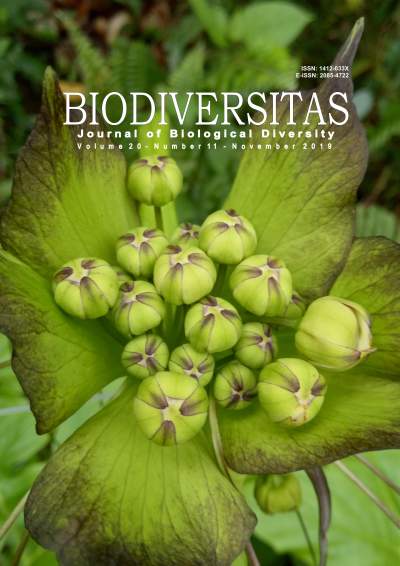Evaluation of salt stress and molecular analysis of genetic variation of Iraqi rice cultivars
##plugins.themes.bootstrap3.article.main##
Abstract
Abstract. Mandal AM, Alhasnawi AN, Jasim H, Mohamad A. 2019. Evaluation of salt stress and molecular analysis of genetic variation of Iraqi rice cultivars. Biodiversitas 20: 3309-3314. The salinity-stress casts an inhibitory effect on rice, which is not only complex but also a key reason for impeding plant growth as well as decreasing crop productivity. A helpful method to improve our understanding in this space would be to make a direct comparison pertaining to the response to salinity by considering two closely related cultivars, i.e. Yassimen and Anber-33, which demonstrate varying levels of salt-tolerance. Exposing rice seeds to high concentrations of 200mM NaCl stress resulted in considerable impact on shoot, chlorophyll content and root growth. The growth of both cultivars was considerably decreased due to salt toxicity. A range of differences was seen in terms of growth parameters due to interaction between cultivars and salt levels. It can be said that the various cultivars vary in terms of their salt tolerance with regards to seedling growth and seed germination. Based on the results from the Inter-simple sequence repeats (ISSR) data, cultivar-Anber-33 had 27 bands in total, while for cultivar-Yassimen, it was 25. These results demonstrated that ISSR markers proved to be a valuable method for determining genetic variation, fingerprinting, classification, and identification of Iraqi rice cultivars.
##plugins.themes.bootstrap3.article.details##
Alhasnawi, A. N., Kadhimi, A. A., Isahak, A., Ashraf, M. F., Doni, F., Mohamad, A., et al., 2015. Application of inter simple sequence repeat (ISSR) for detecting genetic analysis in rice (Oryza sativa L.). Journal of Pure and Applied Microbiology, 9(2): 1091–1101.
Alhasnawi, A. N., Mandal, A. M., Jasim, H. M., 2019. Using DNA fingerprinting to detect the genetic relationships in Acacia by inter-simple sequence repeat markers. Journal of Pure and Applied Microbiology, 13(1): 281–288. doi:https://dx.doi.org/10.22207/JPAM.13.1.30
Aroca, R., Porcel, R., Ruiz-lozano, J. M., 2011. Regulation of root water uptake under abiotic stress conditions, (2009), 1–15. doi:10.1093/jxb/err266
Arshi, A., Abdin, M. Z., Iqbal, M., 2015. Ameliorative effects of CaCl2 on growth, ionic relations, and proline content of Senna under salinity stress. Journal ofPlant Nutrition, 28: 101–125. doi:10.1081/PLN-200042185
Chen, H., Lin, Y., Zhang, Q., 2010. Rice. In Genetic Modification of Plants (pp. 423–451). Springer Berlin Heidelberg. doi:10.1007/978-3-642-02391-0
Damanik, R. I., Ismail, M. R., Shamsuddin, Z., Othman, S., Zain, A. M., Maziah, M., 2012. Response of antioxidant systems in oxygen deprived suspension cultures of rice (Oryza sativa L.). Plant Growth Regulation, 67: 83–92. doi:10.1007/s10725-012-9668-4
Damanik, R. I., Maziah, M., Ismail, M. R., Ahmad, S., Zain, A. M., 2010. Responses of the antioxidative enzymes in Malaysian rice (Oryza sativa L.) cultivars under submergence condition. Acta Physiologiae Plantarum, 32(4): 739–747. doi:10.1007/s11738-009-0456-3
Danai-tambhale, S., Kumar, V., Shriram, V., 2011. Differential response of two scented indica rice (Oryza sativa) cultivars under salt stress. Journal of Stress Physiology & Biochemistry, 7(4): 387–397.
El-Bastawisy, Z. M., 2010. Variation in antioxidants among three wheat cultivars varying in tolerance to NaCl. General and Applied Plant Physiology, 36: 189–203.
Ghosh, N., Adak, M. K., Ghosh, P. D., Gupta, S., Gupta, D. N. Sen, Mandal, C., 2011. Differential responses of two rice varieties to salt stress. Plant Biotechnology Reports, 5(1): 89–103. doi:10.1007/s11816-010-0163-y
Goodwin, T. W., 1977. Chemistry and Biochemistry of plant pigments (2nd edition). FEBS Letters, 74(1): 155–162.
Mishra, P., Bhoomika, K., Dubey, R.S., 2013. Differential responses of antioxidative defense system to prolonged salinity stress in salt-tolerant and salt-sensitive Indica rice (Oryza sativa L.) seedlings. Protoplasma, 250(1): 3–19. doi:10.1007/s00709-011-0365-3
Mohamad, A., Alhasnawi, A. N., Kadhimi, A. A., Isahak, A., Yusoff, W. M. W., Radziah, C. M. Z. C., 2017. DNA isolation and optimization of ISSR-PCR reaction system in Oryza sativa L. International Journal on Advanced Science, Engineering and Information Technology, 7(6): 2264–2272.
Ng, W. L., Tan, S. G., 1994. Inter-simple sequence repeat (ISSR) markers?: Are we doing it right. ASM Sci. J., 9(1): 30–39.
Pattanagul, W., Thitisaksakul, M., 2008. Effect of salinity stress on growth and carbohydrate metabolism in three rice (Oryza sativa L.) cultivars differing in salinity tolerance. Indian Journal of Experimental Biology, 46: 736–742.
Rai, M. K., Kalia, R. K., Singh, R., Gangola, M. P., Dhawan, A. K., 2010. Developing stress tolerant plants through in vitro selection-An overview of the recent progress. Environmental and Experimental Botany, 71: 89–98. doi:10.1016/j.envexpbot.2010.10.021
Sathish, P., Gamborg, O. L., Nabors, M. W., 1997. Establishment of stable NaCl-resistant rice plant lines from anther culture: distribution pattern of K+/Na+ in callus and plant cells. Theor Appl Genet, 95: 1203–1209.
Sen, A., Alikamaniglu, S., 2011. Effect of salt stress on growth parameters and antioxidant enzymes of different wheat (Triticum aestivum L.) varieties on in vitro tissue culture. Freseniuns Environmental Bulletin, 20(2): 489–495.
Subash, N., Mohan, H. S. R., 2011. A Simple rationally integrated drought indicator for Rice-wheat productivity. Water Resour Manage, 25, 2425–2447. doi:10.1007/s11269-011-9817-y
Taylor, P., Kaya, C., Kirnak, H., Higgs, D., 2001. Effects of supplementary Potassium and phosphorus on physiological development and mineral nutrition of cucumber and pepper cultivars grown at high salinity (NaCl). Journal of Plant Nutrition, 24(9): 1457–1471.
Wang, J., Chen, L., Wang, Y., Zhang, J., Liang, Y., Xu, D., 2013. A Computational systems biology study for understanding salt tolerance mechanism in rice. PLOS ONE, 8(6): e64929. doi:10.1371/journal.pone.0064929

 https://orcid.org/0000-0003-2817-8807
https://orcid.org/0000-0003-2817-8807